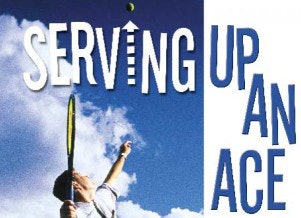Three years into tennis's latest grassroots player-recruitment initiative, municipal-rec and club officials are noticing a change.

Minutes after Serena Williams upset Martina Hingas in the 1999 U.S. Open women's final last September, President Bill Clinton was on the phone from New Zealand, calling to congratulate the 17-year-old Williams on her first major championship. It marked the first time a U.S. president had bothered to contact a winner of the U.S. Open, the richest professional tennis event in the world.
Coincidence? Tennis officials think not. In fact, they've worked diligently for years trying to rekindle warmth from the glory years of the late '70s and early '80s. Today-thanks to the teamwork of the sport's various governing bodies, the cooperation of local communities and the development of an ambitious education program that some proponents claim saved tennis from going the way of the white ball-the game is actually causing quite a racket once again. Even the president of the United States is paying attention.
"The image of tennis is stronger than it's been in a long time," says Kurt Kamperman, president of the Tennis Industry Association, a nonprofit trade organization. "Tennis has a legitimate grassroots program. We recognized five years ago that we had to be proactive in recruiting new players. Remember that Sports Illustrated cover story in 1994-'Is Tennis Dying?' That served as a wake-up call to get everybody to work together to promote tennis."
Central to the game's current revival is the United States Tennis Association's initiative to promote tennis at the local level. A few years back, the USTA kicked off Play Tennis America to get-and keep-first-time players on the courts. That program evolved into what became known as the USA Tennis Plan for Growth, a five-year, $50 million effort that has united in one goal such previously fragmented industry groups as USTA, TIA, the United States Professional Tennis Association and the National Recreation and Park Association. Programs include free first lessons, low-cost classes, and youth and adult leagues.
Now in its third year, the Plan for Growth has worked wonders in communities that 10 years ago didn't even have many tennis courts, let alone quality players. "For the past 15 years or so, tennis hasn't been uppermost in the minds of park and recreation administrators," says Kathy Spangler, NRPA's director of national programs (including tennis). "It's been an art form getting the tennis industry to focus on a single task, but once things start to catch on, they take off very quickly. Tennis is on the upswing."
Indeed, the Plan for Growth has shown park and recreation officials that they need not be based in wealthy communities to promote tennis. (In New York City, for example, the game is keeping inner-city kids out of trouble.) Plus, Kamperman says, buying balls, a racquet and reserving court time (which is generally free) can cost less than a pair of inline skates these days.
Tennis also has benefited from increased television exposure and a new crop of exciting young athletes, especially at the women's level. The allure of players like Hingis, Lindsay Davenport, Anna Kournikova, Mary Pierce, Williams and her older sister, Venus, helped lift attendance on the women's tour last year to its highest numbers in history. "Serena and Venus have been a shining light for diversity in tennis and have as much to do with the sport's increased popularity as the USTA does," Spangler says.
Which brings us back to the U.S. Open, a USTA event that in 1999 boasted its highest attendance and cable-TV ratings ever. "The U.S. Open right now is a very successful event," says Judy Levering, president of the USTA. "And we are doing all we can to make it even more successful. The money that comes from that tournament goes to grow the game. It's important for people to make the connection between the U.S. Open and the grassroots level."
But has the game of tennis really served an ace this time? A bevy of statistics offers confusion at best. While tennis industry figures indicate that 20.8 million people played tennis at least once in 1999, compared to 17.8 million in 1995, the Sporting Goods Manufacturers Association contends that participation has steadily declined since 1990.
"The conflicting statistics are a puzzle to everybody," says Tim Heckler, chief executive officer of the USPTA, a trade association of tennis-teaching professionals. "But I've not spoken to one teaching pro who has said that business is down." Perhaps a better way to gauge the game's growth-or its decline-is to look at various happenings across the country.
When the popularity of tennis reached its peak in 1978, there were fewer activities vying for Americans' leisure time. Extreme sports hadn't yet taken off, soccer and in-line skating enthusiasts weren't clamoring for new facilities, shopping malls were just beginning to catch on, residential use of the Internet was science fiction, and Pong was about it for video games.
Today, it's a different world, which may explain why operators of both public and private facilities in some U.S. cities have been knocking out tennis courts to make way for new skate parks, soccer fields and multipurpose areas. In other communities where tennis courts still stand, weeds poke through cracked surfaces, and weathered nets (if there are nets at all) flap in the wind.
"I ran into one private club owner in Orlando who took out four indoor tennis courts to make room for basketball courts," says Greg Grover, tennis director and vice president of programming and marketing at Windward Lake Club in Alpharetta, Ga., where four new outdoor courts recently were installed next to 16 existing courts. "He told me he was not in the tennis business anymore; he was in the fitness business."
But with recognition of tennis slowly gaining ground once more, people are digging through their garages to find that dusty old racquet. In the Detroit suburb of Southfield, for example, officials have applied for $455,000 in state grants to refurbish three handball courts and rebuild a park's popular but decaying tennis courts.
"Courts are being used again," says Jodie Adams, superintendent of recreation for the Springfield-Greene County (Mo.) Park Board, which boasts a six year-old, $7 million community tennis facility. "Now it's up to city and park system leaders to build facilities to maintain that interest in tennis." Adams invites officials from tennis starved cities to visit Springfield's Cooper Tennis Center to help them develop plans to build facilities of their own. So far, leaders in five out-ofstate communities have taken advantage of the offer. "We pieced together Cooper from what we thought were the best facilities in the country," Adams says about the center's six indoor courts, 17 outdoor courts and sunken stadium court. An additional half-dozen indoor courts are slated for construction within the next couple of years.
Another, smaller tennis complex, which opened in 1980, boasts 12 courts; in all, Springfield has more than 100 courts, indoors and out. The city also is home to one of eight World Team Tennis franchises that vie each summer for the King Cup, named after league founder Billie Jean King. The Springfield Lasers, whose roster features current pro players Larisa Neiland, Grant Stafford, Elena Tatarkova and David MacPherson, are owned by the park board and advanced to the 1999 finals.
"We went from hosting recreational tournaments to running USTA tournaments to owning a pro team," Adams says.
While some tennis skeptics may contend that Springfield officials have gone overboard, it's not hard to find other cities with community leaders excited about the game. The new $1.9 million
Westgate Tennis Center, slated to open this month in Dothan, Ala., is a "collective dream come true," says Kim Meeker, recreation coordinator for the city's leisure services department. Featuring 16 outdoor clay courts-including a sunken championship court for local, state, regional and national events-the beautifully landscaped center was designed for spectators as much as players, Meeker says.
Bleachers, umbrella tables and viewing berms dot the facility. Community lessons, leagues and recreational play will be the focus of the center, which officials have wanted to build since the mid- '90s. A bond-issue vote was finally held in 1999, the same year the USTA recognized Dothan for its model Plan for Growth program. Not bad, Meeker says, for a community that didn't even have a state-ranked player eight years ago.
Last year, voters in Arlington, Texas, also endorsed tennis, approving a $2 million expansion to the Arlington Tennis Center, which will bring the center's total number of outdoor courts to 22. Opened in 1995, the self-sufficient facility is owned and operated by the city, and turned a $40,000 profit last year. The center provides lessons and competition for 4,000 residents each year.
Officials hope to pump participation numbers even higher this spring with the kickoff of a new family program for parents and children that allows them to take lessons at the same time (although on different courts). That way, the center can take advantage of the time parents spend waiting while their kids are in lessons and eliminate the need for child care while parents are in lessons. The new program is being heavily marketed to single-parent and church groups.
It's not just the cooperation of park and recreation officials that is helping tennis succeed at the grassroots level. About 1,000 community tennis associations-nonprofit groups made up of local leaders who strive to make the game more viable to residents-have sprouted up all over the country. Among model CTAs is the Princeton (N.J.) Tennis Program, which leases courts from the city, Princeton University, area high schools and three indoor clubs. Founded 45 years ago by tennis advocate Eve Kraft, the program was instrumental in the development of the Plan for Growth, says Gwen Guidice, executive director of the program. Following the simple philosophy of putting a racquet in someone's hand and having that person hit the ball, the program sponsors lessons, tournaments, in-school programs and other events for about 25,000 participants a year.
A highlight comes each spring with the Free-For-All, a carnival-type event that invites residents to the courts to test the speed of their serves, sample new racquets, hit against ball machines and participate in other fun activities.
From there, program administrators try to sign up attendees for lessons-which Guidice says is the most critical element to keeping tennis alive. "People just don't play tennis if you leave it up to them," Guidice says. "If they pay for eight weeks of lessons, though, they'll show up for eight weeks. I'm an advanced player, but if I don't schedule when I play tennis into my calendar, I don't play tennis."
For some New York City youths, not playing tennis can mean the difference between a life of crime and a sense of purpose. The New York Junior Tennis League, an offshoot of the National Junior Tennis League founded in 1969 by the late Arthur Ashe, runs more than a dozen programs for kids between the ages of 8 and 18-the majority of them African-Americans, Hispanics and Asian-Americans. Each year, the league introduces about 170,000 New York City public school children to the game through physical education programs at 435 sites; of those students, as many as 35,000 go on to participate in follow-up programs, says Skip Hartman, president of the NYJTL and owner of three private tennis clubs in New York City.
"There's no question in my mind that tennis has been a real anchor in a lot of these kids' lives," Hartman says. "Tennis is a blue-chip activity; it's not going anywhere. And it has a very social role, as demonstrated by the success stories from the league." Indeed, program participants have gone on to careers both in and out of tennis. One even attained a No. 6 junior national ranking.
A four-court tennis center in the Bronx, leased by the league for $1 a year, sponsors lessons and tournaments, while a planned $2 million expansion would add three more courts, a multipurpose gymnasium and a clubhouse for studying. "We're very focused on bringing tennis to kids who otherwise wouldn't get a chance to play," Hartman says. "But we want the program to be for all children, because we think tennis is great for bringing people together. If a kid from a wealthy family wants to take lessons, he has to come to the center in a poor neighborhood."
Today, there are roughly 600 junior tennis leagues in the United States, but none of them quite as large or diverse as the one in New York, which operates on a $5.5 million annual budget. The NYJTL also supports education by sponsoring reading clubs, offering college-admission guidance, testing students for college readiness and preparing them for college-entrance exams.
Even though 69 percent of all tennis in America is played on public courts, private clubs are playing a role in the game's revival, too. For example, Windward Lake Club set up a miniature tennis court at last year's Taste of Alpharetta. Grover staffed it with pros from the club who offered hitting and serving pointers. They then encouraged visitors to sign up for a USTA-sponsored free lesson and the USA Tennis 1-2-3 instructional program, both of which are hosted by the club-as are several tournaments and other events that are open to the public. "I'm a private club, and serving my members is my No. 1 priority, but I can still help," Grover says. "I want to create players who might become members. We've been able to make a nice contribution to the community and get some new memberships out of it."
Other club owners haven't had as much success bringing nonmembers through their doors to participate in Plan for Growth programs. "We found that the public is often very reluctant to go into private facilities, especially the higher-end ones," says Gordon Collins, director of tennis at the Courtside Club in Los Gatos, Calif., home of 15 outdoor and three indoor courts. "They wonder if they're good enough, or if they're dressed right."
When the offer of Plan for Growth programs to nonmembers failed to catch fire, Collins decided to sponsor free lessons anyway, targeting members of the club's fitness facilities with an offer to upgrade their memberships. Courtside Club pros also give a free lesson to any inquiring nonmember and offer suggestions about the best type of facility-public or private-for that particular player to improve his or her game. "We've had more success with that than we did with Tennis 1-2-3," Collins says.
Regardless of whether tennis facilities adhere to USTA programs or develop their own, what matters is that, for the most part, tennis isn't being ignored anymore.
And there are other positive signs. The USPTA's Tennis Across America program, a monthlong event held each May to increase interest in tennis, went global last year with Tennis Around the World in such countries as Australia, the Czech Republic, Japan, Singapore, South Africa, Spain and Switzerland.
Meanwhile, the men's pro circuit is trying to spice things up with a new rankings system intended to make stars play all events and keep the No. 1 ranking in doubt until the Masters Cup-the new name for the Association of Tennis Players' World Championship. Players also will receive more fanfare when introduced, á la NBA games or prize fights. Other initiatives are attempting to make the game more friendly for television. These moves, as well as the many others being made by communities and clubs across the country, are helping the industry's goals set forth in the Plan for Growth become a little easier to attain.
Says Adams, "I always felt if we brought all the entities together, which the Plan for Growth has done, we could have a second boom. And we're well on our way."



































